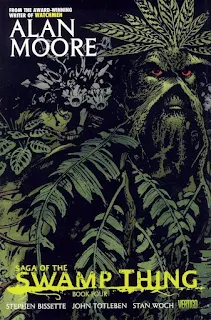I'm more than half-way through my reading of Alan Moore's Saga of the Swamp Thing with my completion of the fourth volume. To an extent, it seems strange that the fourth volume should conclude Moore's "American Gothic" storyline -- given as we are these days to the idea of trilogies, Vol. 4 ought seem to be the set-up for the conclusion of Moore's run (Star Wars to his eventual Return of the Jedi), rather than a clean ending before the two final, seemingly lonely volumes.
[Beware spoilers, ye who enter]
Considering these books in this way, however, is an anachronism first of all because Moore's goal wasn't to write a certain number of Swamp Thing collections (whereas many are writing for the trade today, for better or worse) but rather he was simply writing the Swamp Thing ongoing series. Second, whereas one can't tidily split the Saga of the Swamp Thing collections into the first three and second three volumes, instead perhaps these collections can be seen as two-volume duos -- the first two introductory volumes, through the death of Arcane; the second two volumes, "American Gothic," and then the last two volumes. If one considered buying the Swamp Thing books just a few at a time, then, that might be a way to go about it.
Similar to Swamp Thing Vol. 2, Vol. 4 is also an uneven collection, but not in a bad way. It's just that the second and third chapters are still distinctly "American Gothic," Swamp Thing-on-the-road stories, while the first chapter is a one-off story mainly disconnected from the rest. The fourth chapter is a Crisis on Infinite Earths tie-in that leads directly to the conclusion of "American Gothic." But these, chapters four through seven (about the Parliament of Trees and Constantine and Swamp Thing's battle with the Brujeria witches) are tonally different than the conclusion, which includes again DC's supernatural staples like the Spectre, the Phantom Stranger, Deadman, and others. It's a fine reading experience, but one that continues to shift issue to issue between all the different genres in which Swamp Thing fits.
Considering the pairings of the various Saga volumes, it's notable that the Phantom Stranger, Etrigan the Demon, and the rest are back in "American Gothic"'s conclusion just the same as they capped off the Arcane story in Vol. 2; in this way, Moore can be seen to cycle Swamp Thing through similar conflicts, but with a character that becomes refined and sharper with each pass (if the supernatural lot appear in Vol. 6, too, then we'll have the makings of a thesis). Again, having the supernatural lot all together, and the formulaic structure of this volume's big conclusion (Swamp Thing #50), show their age when judged by modern standards, but only I think because they've been emulated so many times since.
The big moment that struck me in this book was not, as I might have expected, the Crisis crossover, which was less exciting and more given to exposition than I would have thought (due, perhaps, to Moore having a crossover handed to him). Instead, continuity work that I am, I was surprised to see Zatara, Zatanna's father, in these pages, and then quickly understood when Zatara is killed in the conclusion. I had apparently conflated "American Gothic" with Zatanna's Search, believing that Zatara died somewhere in said search and that Zatanna's membership in the Justice League followed her father's death; I had surely not thought that Zatara had been alive all the way through Crisis.
In Vol. 4's conclusion, Moore sums up well what Swamp Thing offers as a character different than Superman or Batman, for instance. Though Swamp Thing may be his most frightening and violent in the book's second story, "Boogeyman," it's the peace with which Swamp Thing approaches the ultimate evil in the last chapter, talking of how good grows from evil and vice versa, that saves the day. That Swamp Thing is a happy warrior, the DC Universe's very own peacenik, is a hard concept to illustrate, probably why Swamp Thing is so often second fiddle in these stories.
But the largely pacifist Swamp Thing is an interesting character, and certainly unique among his DC Universe fellows. Even at the end of Saga of the Swamp Thing Vol. 4, it feels as though Alan Moore is just getting started, still cutting away at former depictions of Swamp Thing before he can start on his own thing (one reason the second appearance of DC's supernatural lot here might be a detraction). With the introduction of the Parliament of Trees and such, I'm looking forward to the real "out there" Swamp Thing stories to start with the next volume.
Saga of the Swamp Thing Vol. 4 collects issues #43-50 of the series, with original covers and introductions by Neil Gaiman and Charles Shaar Murray. More to come ...
(Read my review of Saga of the Swamp Thing Vol. 1, Vol. 2, and Vol. 3.)

Man, we've got to get more commentors on here so we can build a real book club around these Swamp Thing reviews.
ReplyDeleteI just finished the last volume in Moore's run because I started before I knew about your site's coverage. Avoiding any spoilers for Vol. 6, I'll just say that a thesis will be made.
But, yeah, the Crisis crossover in this volume just proved that Moore has such an amazing grasp on this complicated character that he can transport him into any event and turn it into a pivotal point in Swamp Thing's overall arc. Etrigan was a real treat in this volume and it's easy to see why he and Constantine were mined in later Vertigo series, like Gaiman's Sandman.
Glad you're enjoying the reviews. There was a good crowd here for the first couple books, but then I think maybe I read too far ahead of them. Anyway, check back Friday for volume 5.
ReplyDelete